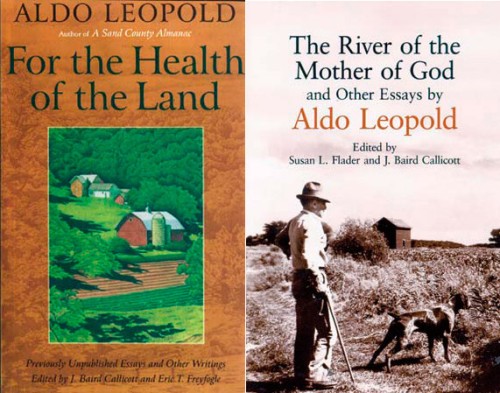by Aldo Leopold
Island Press, 1999 & The University of Wisconsin Press, 1991
I first read Aldo Leopold’s Sand County Almanac in 1971; every year since, I’ve scanned it, quoted from it, lost it, bought it again, moved it, traveled with it, given it as presents, worn it out, loaned it out, and reread it. In the past month, I’ve found two books of previously unpublished or lesser-known Leopold writings, including letters and essays. The first is For the Health of the Land and the second is The River of the Mother of God. Finding these books is like running into a dear friend separated by fortune a long time ago.
These books make clearer Leopold’s evolution from a utilitarian conservationist in the Gifford Pinchot mold to an aesthetic and moral conservationist closer to John Muir. Leopold was inspired by Pinchot to enroll in the Yale School of Forestry, but after receiving a forestry degree, he became a different kind of forest manager. The strictly utilitarian Pinchot supported removing the Hetch Hetchy Valley from the Yosemite National Park so a water supply dam could be built, and he was against preservation of land simply for wilderness or scenic reasons. As one of the founders of the Wilderness Society, Leopold supported preserving wilderness remnants so that we could understand how it develops in the absence of human environmental interference.
He had considerable foresight about potential problems, including his warning about DDT at least a decade before Rachel Carson wrote Silent Spring and his concern about the importation of exotic species. Long before the arrival of the emerald ash borer or the Asian longhorned beetle, he wrote: “World-wide transport is carrying new ‘stowaways’ to new habitats on an ascending scale.”
These books reveal the sturdy foundations that Leopold built on when writing Sand County Almanac. The essays range from two written as a schoolboy in New Jersey in 1904 to an address to the Conservation Committee of the Garden Club of America in 1947 that was later incorporated into “The Land Ethic” in Almanac. For the Health of the Land includes 40 articles written for the Wisconsin Agriculturalist and Farmer. Originally written as seasonal advice to farmers interested in improving wildlife on their farms, many of the essays were rewritten and used in Part I of Almanac. Some of them have never been published before, including “The Land-Health Concept and Conservation,” which was found at the time of his death in a pencil draft.
The Sand County Almanac is a polished, almost meditative volume that often omits specifics, such as place names, to make generalized statements. The essays in these two books often address a particular issue, place, and time, and illustrate a sharpness and impatience not seen in Almanac. His battles with state legislatures that overrode the good advice of conservation commissions were pointed. The articles “The Last Stand,” about the last uncut hardwood in Michigan’s Porcupine Mountains, and “Land Use and Democracy,” on the moral responsibility for conservation that consumers must shoulder, have an immediacy and bite that make you stand up and notice.
At times, Leopold’s writings leave me thinking that we’ve failed to be guided by his wisdom for the past 80 plus years. At other times, I see an idea of his and can say that we are truly working hard at it and quite often succeeding. As we make some small progress toward healing the land, we can perhaps be reminded that Leopold had “no illusions about the speed or accuracy with which an ecological conscience can become functional.”


